Guadeloupe amazon
| Guadeloupe amazon | |
|---|---|
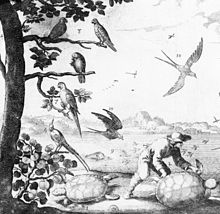
| |
Du Tertre's 1667 illustration showing three Guadeloupe amazons (8) and one Lesser Antillean macaw (7) on a tree at the left
| |
| Scientific classification | |
| Domain: | Eukaryota |
| Kingdom: | Animalia |
| Phylum: | Chordata |
| Class: | Aves |
| Order: | Psittaciformes |
| Family: | Psittacidae |
| Genus: | Amazona |
| Species: | †A. violacea
|
| Binomial name | |
| †Amazona violacea (Gmelin, 1789)
| |
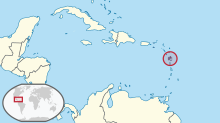
| |
| Location of Guadeloupe | |
| Synonyms | |
|
List
| |
The Guadeloupe amazon or Guadeloupe parrot (Amazona violacea) is a
According to contemporary descriptions, the head, neck and underparts of the Guadeloupe amazon were mainly violet or slate, mixed with green and black; the back was brownish green; and the wings were green, yellow and red. It had
Taxonomy
The Guadeloupe amazon was first described in 1664 by the French botanist
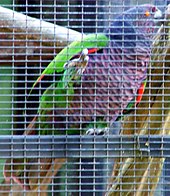
In 1891, the Italian zoologist
In 2001, the American ornithologists Matthew Williams and
The "violet macaw"
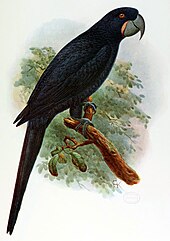
In 1905, the British banker and zoologist
In 2000, the English writer
In 2015, Lenoble reviewed overlooked historical Spanish and French texts, and identified the sources on which Rothschild had based the violet macaw. An 1828 publication by de Navarrete mentioned parrots on Guadeloupe during the second voyage of Columbus, but did not state their colour or include the term "onécouli". Lenoble instead pointed to a Carib-French dictionary by the French missionary
Description

Du Tertre described the Guadeloupe amazon as follows in 1654:
The Parrot of Guadeloupe is almost as large as a fowl. The beak and the eye are bordered with carnation. All the feathers of the head, neck, and underparts are of a violet color, mixed with a little green and black, and changeable like the throat of a pigeon. All the upper part of the back is brownish green. The long quills are black, the others yellow, green, and red, and it has on the wing-coverts two rosettes of rose color.[2]
Labat described the bird as follows in 1742:
The Parrots of these islands are distinguishable from those of the mainland of Guinea (? Guiana) by their different plumage; those of Guadeloupe are a little smaller than the Macaws. The head, neck, and underparts are slaty, with a few green and black feathers; the back is wholly green, the wings green, yellow, and red.[2]
Clark noted that the
As well as being described as violet by Du Tertre and slate by Labat, the head and underparts of the bird were described as ashy blue by Brisson. Greenway suggested some of this discrepancy may have been because Labat confused the Guadeloupe amazon with the Martinique amazon, as he appears not to have distinguished between the birds. Hume consolidated these descriptions under the term "slaty-blue".[2][8][4]
Rothschild featured an illustration of the Guadeloupe amazon in his 1907 book
Behaviour and ecology
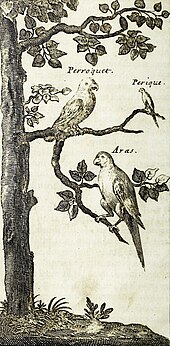
In 1664 Du Tertre described some behavioural traits of the Guadeloupe amazon, and listed items among its diet:
When it erects the feathers of its neck, it makes a beautiful ruff about its head, which it seems to admire, as a peacock its tail. It has a strong voice, talks very distinctly, and learns quickly if taken young. It lives on the wild fruits which grow in the forests, except that it does not eat the manchioneel. Cotton seed intoxicates it, and affects it as wine does a man; and for that reason they eat it with great eagerness ... The flavor of its flesh is excellent, but changeable, according to the kind of food. If it eats cashew nuts, the flesh has an agreeable flavor of garlic; if 'bois des inde' it has a flavor of cloves and cinnamon; if on bitter fruits, it becomes bitter like gall. If it feeds on genips, the flesh becomes wholly black, but that does not prevent its having a very fine flavor. When it feeds on guavas it is at its best, and then the French commit great havoc among them.[2]
Clark noted that the Saint Vincent amazon and other amazon species can also raise a "ruff" of feathers around their neck when excited.[2]
In 1667, Du Tertre repeated his description of the Guadeloupe amazon, and added some details about its breeding behaviour:
We had two which built their nest a hundred paces from our house in a large tree. The male and the female sat alternately, and came one after the other to feed at the house, where they brought their young when they were large enough to leave the nest.[2]
Extinction
In 1779, Buffon stated that the Guadeloupe amazon had become very rare, and indicated why it may have become extinct:[4]
We have never seen this parrot, and it is not found in Cayenne. It is even very rare in Guadeloupe today, for none of the inhabitants of that island have given us any information concerning it; but that is not extraordinary, for since the islands have been inhabited, the number of parrots has greatly diminished, and Dutertre remarks in particular of this one that the French colonists wage a terrible war on it in the season when it is especially fat and succulent.[2]
Greenway suggested that both the French settlers and their slaves ate the Guadeloupe amazon as well as destroyed its habitat. The supposedly related imperial amazon survives in the steep mountain forests of Dominica. Guadeloupe is less mountainous than Dominica, more suitable for farming and, historically, has had a larger human population. Because of this, there would have been a greater pressure on the Guadeloupe amazon and it appears to have become extinct by the end of the 18th century. All the amazon species still extant on the West Indian islands are endangered, since they are trapped for the pet-trade and overhunted for food, and also because of destruction of their habitat.[4][8]
References
- . Retrieved 13 November 2021.
- ^ JSTOR 4069996.
- .
- ^ ISBN 978-1-4081-5725-1.
- ISBN 978-1408133262.
- .
- ISBN 978-1-4081-2501-4.
- ^ ISBN 978-0-486-21869-4.
- ^ ISBN 978-0-8493-2001-9. Archived from the original(PDF) on 2014-02-07.
- ^ Ottens-Wainright, P.; Halanych, K. M.; Eberhard, J. R.; Burke, R. I.; Wiley, J. W.; Gnam, R. S.; Aguilera, X. G. (2004). "Independent geographic origin of the genus Amazona in the West Indies". Journal of Caribbean Ornithology. 17: 23–49.
- ^ S2CID 54593515.
- S2CID 18597644.
- ^ Rothschild, W. (1905). "Notes on extinct parrots from the West Indies". Bulletin of the British Ornithologists' Club. 16: 13–15.
- ^ Rothschild, W. (1905). "On extinct and vanishing birds". Ornis (Proceedings of the 4th International Ornithological Congress, London). 14: 191–217.
- ^ a b Rothschild, W. (1907). Extinct Birds. London: Hutchinson & Co. pp. 55–57.
- ISBN 978-0-670-81787-0.
- ^ Wiley, J. W.; Kirwan, G. M. (2013). "The extinct macaws of the West Indies, with special reference to Cuban Macaw Ara tricolor". Bulletin of the British Ornithologists' Club. 133: 125–156.
- ^ a b Lenoble, A. (2015). "The Violet Macaw (Anodorhynchus purpurascens Rothschild, 1905) did not exist". Journal of Caribbean Ornithology. 28: 17–21.
- ISBN 978-2-900339-13-8.
- LCCN 11035036.

